A Machine Operator Died When Crushed In an Automatic Feed System of a Cardboard Box Waxing Machine
Investigation: # 03CA001
SUMMARY
A Hispanic machine operator died after he entered the automatic feed system of a cardboard box waxing system and was crushed. The victim was the operator of the machine and was working the swing shift. The machine was equipped with electronic eye sensors that controlled movement of materials along a conveyor. The victim did not use the company’s lockout/tagout procedure before entering the machine while it was running. The California FACE investigator determined that in order to prevent future occurrences, employers, as part of their Injury and Illness Prevention Program (IIPP) should:
- Ensure that the lockout/tagout procedure is implemented whenever employees enter machine danger zones.
In addition, manufacturer’s should:
- Ensure machines are engineered to prevent employees from entering danger zones.
INTRODUCTION
On January 13, 2003, at approximately 4:40 p.m., a 43-year-old Hispanic machine operator was killed when he got caught in the hydraulic mechanism of an automatic feed system for a machine that waxes cardboard boxes. The CA/FACE investigator learned of this incident on January 15, 2003, through the Legal Unit of the Division of Occupational Safety and Health (Cal/OSHA). On January 27, 2003, the CA/FACE investigator traveled to the victim’s place of employment where he interviewed the company’s Safety Manager and other employees in the plant. The investigator also inspected the incident site and took pictures of the machine involved in the incident.
The employer of the victim was a manufacturer of corrugated boxes. The employer had been in business for over 100 years and had approximately 60,000 employees nationwide. There were 130 employees at the facility where the incident occurred. The victim had been employed with the company for 22 years. The victim was born in Nicaragua. He had been in the United States for 22 years and, according to his employer, he spoke and read English well. The victim had a 12th grade education, and other employees stated they had no difficulty talking with him in English.
The employer of the victim had a safety program and an IIPP. There were written task-specific safe work procedures for some, but not all, tasks performed in the shop. Safety meetings were held monthly and were documented. Training was usually accomplished by on-the-job-training (OJT) by experienced machine operators. The victim was one of the company’s experienced machine operators who trained other operators. The employees’ proficiency after training was measured through demonstration of their skills. Records of their training were maintained.
INVESTIGATION
The employer at the site of the incident was a manufacturer and distributor of cardboard boxes for industrial and commercial use. The machine involved in this incident was an automatic feed system that guided boxes into a waxing machine (exhibit #1). Boxes were waxed to increase their strength capacity. Cardboard boxes were brought to the machine by automated conveyor rollers (exhibit #2). The boxes were then pushed onto a feed table (exhibit #3) that took the boxes and centered them under the feed system. The feed table would then rise until the boxes were pressed against the rollers of the feed system (exhibit #4). As the rollers of the feed system would shuffle the boxes onto the waxing conveyor, the feed table continued to rise to keep pressure on the rollers until all the boxes were gone. All actions of the system were controlled by electronic eye sensors.
On the evening of the incident, the victim started his shift at 3:30 pm and set up his machine. The boxes being waxed were for produce. At approximately 4:40 pm, a coworker who was working close by heard the victim call for help. He went to the victim‘s machine and found him caught between the frame and lift table mechanism. It is unknown what the victim was doing at the time he was caught. The coworker immediately pushed the machine’s emergency stop button. He then went and got the supervisor. Paramedics were called and responded within minutes. The hydraulic hoses to the lift table were loosened in order to move the table to the right to release the victim. The victim was removed from the machine and taken to the hospital where he died from his injures two days later.
CAUSE OF DEATH
The cause of death, according to the death certificate, was sequelae of asphyxia and multiple blunt force injuries.
RECOMMENDATIONS/DISCUSSION
Recommendation #1: Ensure that the lockout/tagout procedure is implemented whenever employees enter machine danger zones.
Discussion: The employer of the victim had a lockout/tagout procedure that should have been implemented by the operator before entering the machine. It is unknown why the lockout/tagout procedure was not implemented. Safe work practices can be assured through programs of training, supervision, rewards, and progressive disciplinary measures.
Recommendation #2: Manufacturer’s should ensure machines are engineered to prevent employees from entering danger zones.
Discussion: This particular machine had electronic eye sensors installed that controlled every movement of the feed system. Future prevention of similar incidents might require guarding or more sensors to detect the operator’s movements as well as the machine’s.
REFERENCES
- California Code of Regulations, Vol. 9, Title 8, Sections 3314, 4184.
FATALITY ASSESSMENT AND CONTROL EVALUATION PROGRAM
The California Department of Health Services, in cooperation with the California Public Health Institute, and the National Institute for Occupational Safety and Health (NIOSH), conducts investigations on work-related fatalities. The goal of this program, known as the California Fatality Assessment and Control Evaluation (CA/FACE), is to prevent fatal work injuries in the future. CA/FACE aims to achieve this goal by studying the work environment, the worker, the task the worker was performing, the tools the worker was using, the energy exchange resulting in fatal injury, and the role of management in controlling how these factors interact.
NIOSH funded state-based FACE programs include: Alaska, California, Iowa, Kentucky, Massachusetts, Michigan, Minnesota, Nebraska, New Jersey, New York, Oklahoma, Oregon, Washington, West Virginia, and Wisconsin.
To contact California State FACE program personnel regarding State-based FACE reports, please use information listed on the Contact Sheet on the NIOSH FACE website. Please contact In-house FACE program personnel regarding In-house FACE reports and to gain assistance when State-FACE program personnel cannot be reached.
EXHIBITS
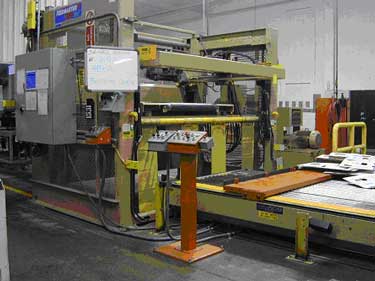 |
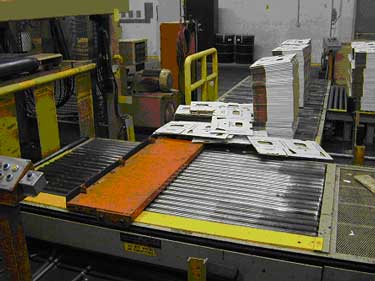 |
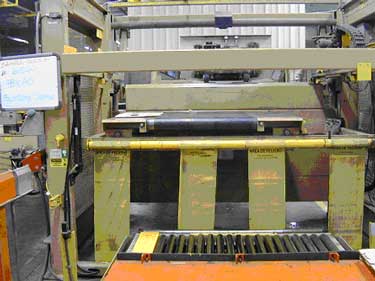 |
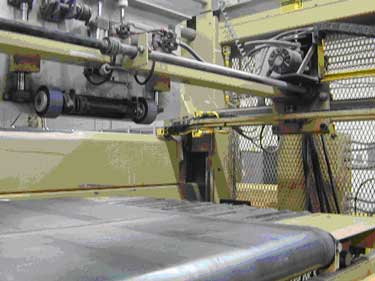 |
|
Exhibit #4. A picture of the rollers of the feed system that shuffles each box into the waxing system.
|
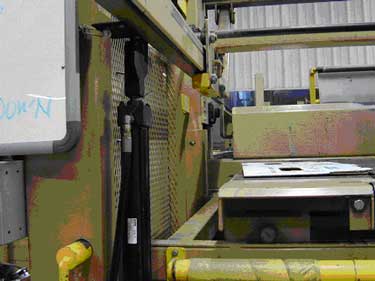 |
|
Exhibit #5. A view of the left side of the feed table where the victim was crushed.
|
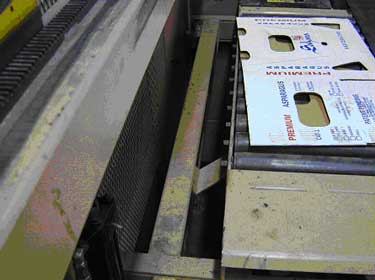 |
|
Exhibit #6. A view of the left side of the feed table looking down at the area where the victim was caught.
|
